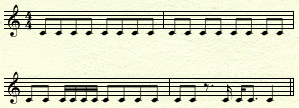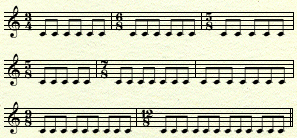Discussions of imaginary barlines tend to get very mathematical. It’s easier to think of them in terms of clarifying syncopation.
An imaginary barline is a notation convention designed to help the music reader know what’s syncopated—off the beat—and what’s not. It’s not an actual notation mark; it is an understanding and a notation convention.
In 4/4, the imaginary barline separates beats 1 and 2 from beats 3 and 4. Only whole notes and non-syncopated half and dotted half notes can be notated as “crossing the imaginary barline.” No other note durations can cross them. Rather, they must be rewritten as pairs of tied notes, with beat 3 being shown. This makes the notation much easier to read.
So, these are acceptable:

The ones below are not acceptable. Again, the reason is that the notes crossing the imaginary barline disguise the fact that the music is syncopated.

Much easier to follow are the following revisions. The notes are tied, and the target note of the tie re-articulates beat 3, and thus clarifies where the syncopation lies.

In some Latin music, there is a notable notation exception to this convention: bass lines with the following syncopated rhythm. But this is a rare acceptable exception to the general rule.

Beams never cross imaginary barlines. Some publishers group beats on each side of it together, while others begin new beam groups on every beat. Here are other ways to clarify the metric organization.
These are correct:

These are incorrect:

Similarly, beams are used to clarify other meters besides 4/4, and the other rules of imaginary barlines also apply to them. Many of these signatures can be interpreted in a variety of ways, and thoughtful beaming can greatly clarify how the music is to be performed. Again, it’s about clarifying subdivisions and which beats are emphasized. Meters have subdivisions every two or three beats, and more complex time signatures (e.g., 7/8, 12/8) might have multiple imaginary barlines to consider. Below, the beams show how some other meters are commonly organized. Other options are available.

This concept of clarifying syncopations also applies when you drill down deeper, into smaller divisions of the measure. For example, this notation clarifies beat 2, and thus the fact that the notation is off the beat. This is a clear way to write that rhythm because the relationship between the sounding notes and the meter is clarified, via the tie.

Here, however, the syncopation is more difficult to figure out, and thus, to be avoided.

These “rules” of notation help make music as easy to read, and thus, interpret. When the notation follows the music’s intent, it becomes much easier for the reader to understand, especially at a glance.
STUDY MUSIC THEORY WITH BERKLEE ONLINE







